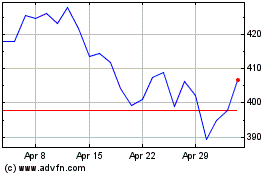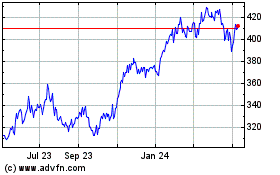Trading Glitch Briefly Sets Apple, Amazon and Microsoft Stock Prices at $123.47 -- 2nd Update
July 04 2017 - 1:53AM
Dow Jones News
By Steven Russolillo
A flood of incorrect stock-market data briefly hit traders'
screens around the globe early Tuesday morning in Asia, showing
apparent huge moves in the Nasdaq-listed share prices of some of
the world's biggest companies including tech giants Apple Inc.,
Microsoft Corp. and Amazon.com Inc.
The faulty data on stock prices appeared on several platforms
including Yahoo Finance, Google Finance and on Bloomberg terminals
between 6 a.m. and 7 a.m. Hong Kong time, after U.S. markets had
closed early on Monday ahead of the annual Independence Day
holiday.
As a result of the glitch, which Nasdaq said was caused by
faulty test data being improperly disseminated by third-party
vendors including Bloomberg, several stocks briefly showed their
price to be $123.47--equivalent to a 14% drop in Apple's shares, an
87% plunge for Amazon and a 79% surge for Microsoft.
If the declines had actually occurred, it would have knocked
$104 billion off the market value of Apple, the world's most
valuable stock. Amazon's market cap would have dropped $396
billion, while Microsoft's would have risen $415 billion.
Joe Christinat, a Nasdaq spokesman, said no actual trades were
affected by the glitch.
"This is a vendor issue, not a Nasdaq issue," he said, noting
that others such as FactSet and even Nasdaq.com showed correct
pricing data.
A Bloomberg spokesperson said inquiries should be directed to
Nasdaq and didn't comment beyond that.
Stock markets in the U.S. were only open for half a day on
Monday and will be closed Tuesday for Independence Day. Aftermarket
hours on Nasdaq, during which stocks trade after the traditional
trading day has closed, usually last for four hours. The market
typically closes at 4 p.m. ET. But Nasdaq's Mr. Christinat said the
early close at 1 p.m. ET on Monday might have played a role in the
confusion that prompted the improper use and dissemination of test
data, which he said is sent out after every trading day.
"I've seen quite a few fat-finger incidents when you get a funny
price briefly," said Eric Moffett, a portfolio manager for the T.
Rowe Price Asia Opportunities Equity Fund in Hong Kong. "When I saw
the series of alerts, I figured something was up."
Mr. Moffett said he takes a long-term view on the stocks his
fund invests in, so any sharp moves in the market--fat finger or
not--likely won't prompt any significant trading activity. Even so,
he said the flurry of alerts related to the pricing issues caught
his attention.
"I immediately wondered with something like this if there was
some sort of cyberattack," Mr. Moffett said.
A slew of high-profile trading glitches have roiled markets in
recent years. In May 2010, the Dow Jones Industrial Average plunged
nearly 1000 points in a matter of minutes before rebounding quickly
in what widely became known as the "flash crash." In August 2013, a
technical glitch knocked out trading in all Nasdaq Stock Market
securities for three hours due to a problem with the data feed that
supplied trade information. In July 2015, a glitch forced the New
York Stock Exchange to halt trading for nearly four hours.
The difference this time is that no trades appear to have been
affected by the latest fiasco. A trader notice from Nasdaq said
"certain third parties improperly propagated test data that was
distributed as part of the normal evening test procedures." The
notice added: "All production data was completed by 5:16 p.m. ET as
expected per the early close of the markets. Any data messages
received post 5:16 p.m. should be deemed as test data and purged
from direct data recipient's databases."
A system status message posted on Nasdaq's website said "systems
are operating normally." But not all stock quotes appeared to be
accurate. Shares in Nasdaq-listed biotech giant Amgen Inc. were
still being incorrectly shown down 28% at $123.45 on Google Finance
by late morning Asia time. The stock actually closed Monday at
$172.80.
Write to Steven Russolillo at steven.russolillo@wsj.com
(END) Dow Jones Newswires
July 04, 2017 01:38 ET (05:38 GMT)
Copyright (c) 2017 Dow Jones & Company, Inc.
Microsoft (NASDAQ:MSFT)
Historical Stock Chart
From Mar 2024 to Apr 2024

Microsoft (NASDAQ:MSFT)
Historical Stock Chart
From Apr 2023 to Apr 2024
